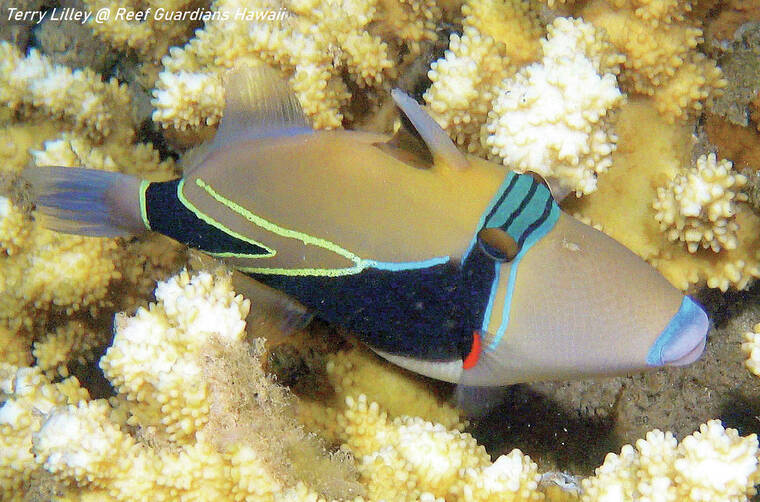As a marine biologist studying Hawaiian reef fish all throughout the Hawaiian chain, I like how the Hawaiian people have named their fish species. The Hawaiian name has a meaning, which often describes how the fish looks, its behavior and or its connection to land animals and plants. To better understand each fish species, it is good to understand its Hawaiian name. But that can sometimes be difficult.
Hundreds of years ago, when many Hawaiian fish were named, people did not write down the interpretation of the name, as it was just passed down orally from generation to generation. This has caused a problem for us today, because the meaning of many Hawaiian fish names has been lost. The Hawaiian state fish, the wedgetail triggerfish, is a common fish species, and most folks nowadays can say its Hawaiian name. But does anyone know what the entire name means?
Many Hawaiian words are spelled the same, but may have different meanings. In the wedgetail triggerfish name “humu” is repeated twice, but the common interpretation of “humu” is a stitched pattern and, sure enough, the fish pattern looks like several pieces of fabric stitched together. But what does the second humu mean? Quite the mystery. But we may have solved it.
For several years I worked with Rubellite Kawena Johnson, who is a Hawaiian language expert, who transcribed the Hawaiian Kumulipo. It is 3,000 pages of oral history describing the creation of Hawai‘i and all living creatures that call Hawai‘i home. I asked Auntie Ruby what the second humu means in the triggerfish name; she did some research. What she discovered may just cause the interpretation of this special reef fish to be changed.
Auntie Ruby watched my movie “The World’s Guide To Hawaiian Reef Fish,” where I describe the behavior of the triggerfish. In the movie, I show how the fish darts into a hole in the reef when threatened, and the fish knows all of the holes that lace through the lava reef. Rubellite went back in time 6,000 years ago in Egypt, and there was a star that had its own passageway through the galaxy. The star was called Humu. Armed with this new information, Auntie Ruby went back in time a thousand years ago, and in the wetlands of Pearl Harbor the Native Hawaiians had a passageway through the reeds called a “humu.”
We know that the “nuku nuku” in the triggerfish name means “sharp horn,” and “a-pua‘a” refers to a pig. So, now, just maybe, we know the interpretation of the long Hawaiian name humuhumu-nukunuku-a-pua‘a is “the fish with the stitched pattern that knows the passageways through the reef that has a sharp horn and grunts like a pig.”
Many Hawaiian fish names are open for interpretation and may be changed in the future because there is a better understanding of Hawaiian names all the time. But for now, it is super fun to try and figure out how the names relate to each fish species.
You can see humuhumu-nukunuku-a-pua‘a in action darting into the passageways of the reef up on my marine life educational webpage at www.underwater2web.com and my YouTube at Underwater2web. Feel free to sign up on my YouTube, as I am doing a new movie all about our state fish, and you will get the movie first as soon as it is posted.
•••
Terry Lilley is a marine biologist living in Hanalei. He is co-founder of Reef Guardians Hawai‘i, a nonprofit on a mission to provide education and resources to protect the coral reef. To donate to Reef Guardians Hawaii go to www.reefguardianshawaii.org.






Amazing! I can’t wait to lay this interpretation on someone next time I go snorkeling and see a Humu. Mahalo Terry as always for your fascinating research.